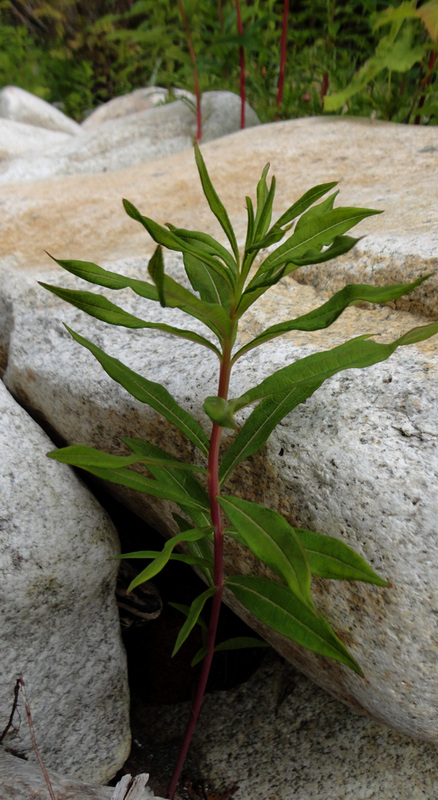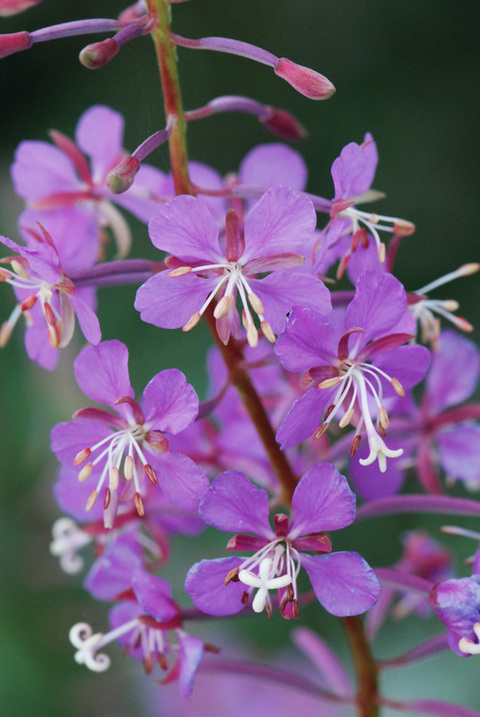Fireweed, rosebay willowherb • Epilobium angustifolium
Identification
Fireweed is a perennial species belonging to the Evening Primrose family. Its leafy stems grow 1-3 m tall. Its leaves alternate along the stem and are long and pointed. When in bloom its pink to purple flowers form a long cluster at the stem top. The seeds are fluffy and white. There are two subspecies present in BC; see the E-Flora BC species page for details.
Habitat & Range
Fireweed can be prolific in moist to dry disturbed and open sites, such as meadows, avalanche tracks, thickets, and roadsides. It is commonly an early successional species in patches left bare by forest fire. It is a common species in BC, and is found throughout much of northern North America and Eurasia.
Human Uses
Traditional coastal First Nations uses of fireweed include using the stems to make cord and fishing nets and using the seed fluff for weaving and as stuffing in mattresses. The stems of young shoots are a traditional food. The leaves, rich in vitamin C, can be used to make tea, and the abundant nectar produced by fireweed flowers makes delicious honey. Tea, honey, and other recipes, as well as further information on food uses, are available in this University of Alaska Fairbanks publication.
Fireweed is a perennial species belonging to the Evening Primrose family. Its leafy stems grow 1-3 m tall. Its leaves alternate along the stem and are long and pointed. When in bloom its pink to purple flowers form a long cluster at the stem top. The seeds are fluffy and white. There are two subspecies present in BC; see the E-Flora BC species page for details.
Habitat & Range
Fireweed can be prolific in moist to dry disturbed and open sites, such as meadows, avalanche tracks, thickets, and roadsides. It is commonly an early successional species in patches left bare by forest fire. It is a common species in BC, and is found throughout much of northern North America and Eurasia.
Human Uses
Traditional coastal First Nations uses of fireweed include using the stems to make cord and fishing nets and using the seed fluff for weaving and as stuffing in mattresses. The stems of young shoots are a traditional food. The leaves, rich in vitamin C, can be used to make tea, and the abundant nectar produced by fireweed flowers makes delicious honey. Tea, honey, and other recipes, as well as further information on food uses, are available in this University of Alaska Fairbanks publication.
References
Epilobium angustifolium L. In Klinkenberg, Brian. (Ed.). E-Flora BC: Electronic Atlas of the Plants of British Columbia. Lab for Advanced Spatial Analysis, Department of Geography, University of British Columbia, Vancouver. Accessed 15/10/2014.
Pojar, J. and MacKinnon, A. (1994). Plants of Coastal British Columbia. Vancouver, BC: Lone Pine Publishing. P. 206.
Authors and editors of page
Kelly Fretwell, Misha Warbanski, and Brian Starzomski
Epilobium angustifolium L. In Klinkenberg, Brian. (Ed.). E-Flora BC: Electronic Atlas of the Plants of British Columbia. Lab for Advanced Spatial Analysis, Department of Geography, University of British Columbia, Vancouver. Accessed 15/10/2014.
Pojar, J. and MacKinnon, A. (1994). Plants of Coastal British Columbia. Vancouver, BC: Lone Pine Publishing. P. 206.
Authors and editors of page
Kelly Fretwell, Misha Warbanski, and Brian Starzomski






